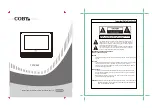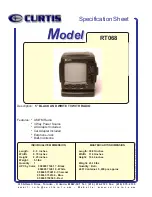
SW1
R2
+
6 VOLT
LANTERN
BATTERY
A
R1
SW2
G
C
SCR
UNDER
TEST
To test SCRs construct the circuit outlined above. Resistor values are plus or minus
ten percent. The voltmeter scale should be low, approximately 0-5 or 0-10 volts DC.
R1 = 4 ohms / 10 watts
R2 = 3 ohms / 10 watts
V
SW1
R2
+
6 VOLT
LANTERN
BATTERY
A
R1
SW2
G
C
SCR
UNDER
TEST
To test SCRs construct the circuit outlined above. Resistor values are plus or minus
ten percent. The voltmeter scale should be low, approximately 0-5 or 0-10 volts DC.
R1 = 4 ohms / 10 watts
R2 = 3 ohms / 10 watts
V
FIGURE F.18 – SCR TEST SETUP
ACTIVE SCR TEST PROCEDURE (continued)
4. To test SCRs, construct the circuit outlined in
Figure F.18. Use one 6V lantern battery.
Resistor values are in ohms ±10%. The volt-
meter scale should be low, approximately 0-5
or 0-10 volts.
BATTERY TEST
Check the battery by shorting leads (A) and (C)
and then close switch SW1. Replace battery if volt-
age is less than 4.5 volts.
A. Connect SCR into the test circuit as shown (A)
lead to anode (C) lead to cathode and (G) lead
to the gate. See
B. Close switch SW1 (switch SW2 should open),
voltmeter should read zero. If the voltmeter
reads higher than zero the SCR is shorted.
NOTE:
Do not disassemble the heat sinks.
5. With switch SW1 closed, close switch SW2 for
two seconds and release. The voltmeter
should read 3 to 6 volts before and after switch
SW2 is released. If the voltmeter does not
read, or reads only while SW2 is depressed,
the SCR or battery is defective (repeat Battery
Test Procedure).
6. Open switch SW1, disconnect the gate lead
(G) and reverse the (A) and (C) leads on the
SCR. Close switch SW2. The voltmeter should
read zero. If the voltage is higher than zero, the
SCR is shorted.
7. Replace any SCR assembly that does not
pass test in Step 4.
TROUBLESHOOTING AND REPAIR
F-44
F-44
IDEALARC® DC-1500
















































